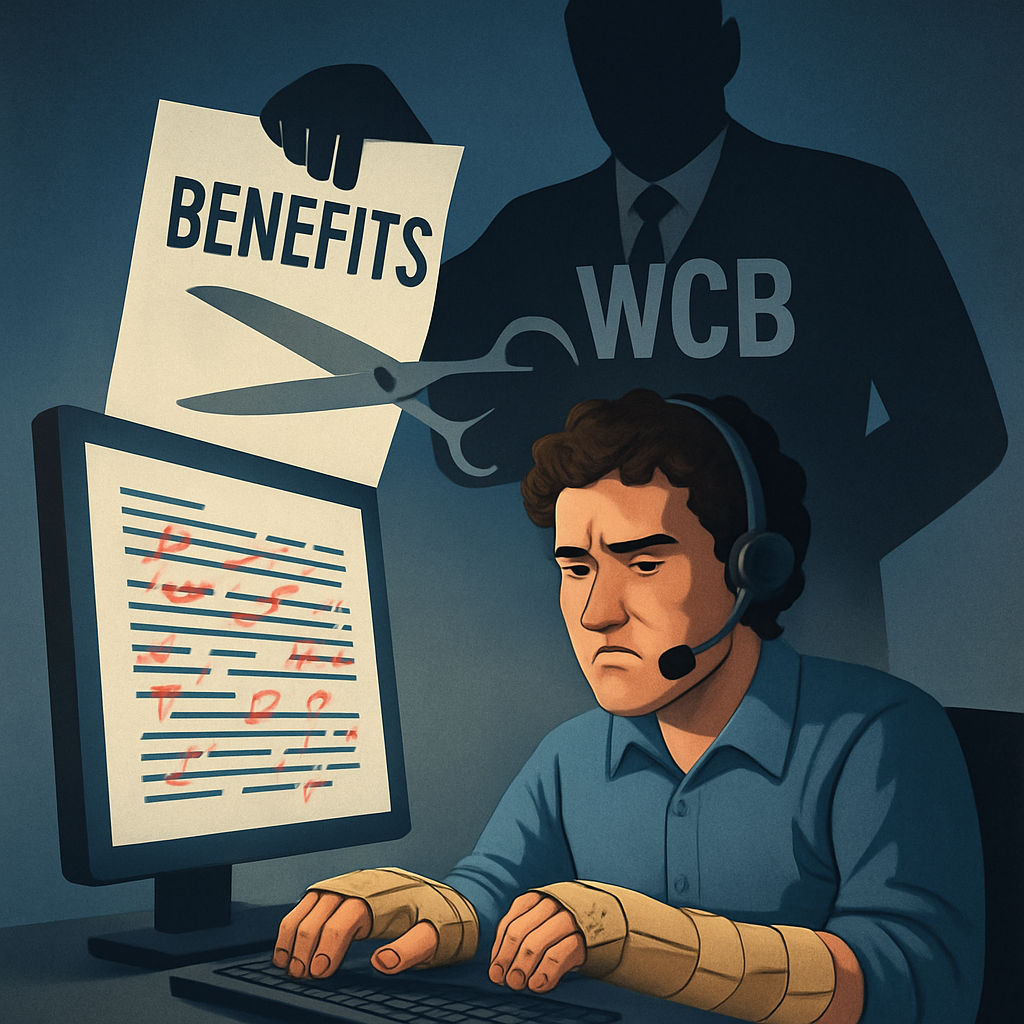When a physician says, “This worker no longer has any meaningful use of their arms,” most people would assume that the workers’ comp would take that statement seriously. Unfortunately, reality doesn’t align with that assumption. Rather than acknowledge permanent injury and the barriers it creates, WCB often falls back on a convenient illusion: Voice Recognition Training (VRT).
On the surface, VRT seems like an elegant technological fix—if someone can’t use their hands, why not just use their voice? It’s tidy. It’s futuristic. And best of all (for the Board that is), it’s inexpensive. But once you scratch beneath the surface, you’ll find that this high-tech solution isn’t a solution at all. In fact, it’s often a trap.
The Reality Gap
Let’s start with the basics. Even the best voice recognition systems top out at about 80% accuracy under ideal conditions. That might sound serviceable—until you realize that human transcription accuracy averages closer to 96–98%, and the margin of error becomes glaring in jobs that require precision. In law, engineering, accounting, technical drafting, and other detail-driven fields, even small errors can have major consequences.
WCB’s oversimplification of voice tech ignores what happens when the software makes mistakes. And it does—constantly. The injured worker is then forced to correct those errors manually. For someone with severe carpal tunnel syndrome, nerve damage, or tendonitis, this isn’t just a minor inconvenience—it’s a direct contradiction of their medical restrictions. It’s painful. It’s risky. And it flies in the face of the very diagnoses WCB has accepted.
Simple commands like “select that paragraph,” “change the font to 12-point,” or “move it three lines down” can quickly devolve into frustrating loops of misinterpretation, corrections, and re-dos. And once fatigue sets in, voice systems become even more unreliable, compounding the problem.
Voice recognition technology is simply not ready to serve as a replacement for hands in complex, high-accuracy digital environments. WCB knows this—or ought to. And yet, they continue to push it.
The Employment Reality Check
Let’s shift to the job market. Imagine you’re an employer. Would you hire someone who:
-
Has no prior office experience
-
Recently completed a short course in voice recognition
-
Works significantly slower than their peers
-
Requires a private office due to the disruptive nature of voice commands
-
Needs specialized equipment and ongoing tech support
In practice, most employers wouldn’t even consider it. Many who pride themselves on inclusive hiring admit that accommodating a VRT-dependent worker requires re-engineering workflows, software compatibility audits, custom setups, and extra staff training—things few have the resources or flexibility to manage.
One HR director put it bluntly:
“We’d love to accommodate everyone, but we’d essentially have to build a separate infrastructure for one person. It’s just not feasible.”
The unfortunate truth is that the workplace isn’t ready to absorb VRT-trained workers—not at scale, and certainly not in specialized roles. But WCB pushes ahead anyway.
The Real Agenda: Cost-Cutting
Despite the glossy spin, Voice Recognition Training isn’t about rehabilitation or reintegration. It’s about cost containment.
Here’s how the playbook typically unfolds:
-
Identify theoretical jobs that might be done using voice software.
-
Provide minimal training—usually just a few weeks.
-
Declare the worker “employable.”
-
Terminate or reduce wage-loss benefits.
-
Leave the injured worker to fend for themselves in an unsympathetic job market.
By doing this, WCB offloads responsibility and shifts the burden to the worker. And when the inevitable happens—when the worker can’t get hired—WCB blames them, not the flawed strategy.
This isn’t an oversight. It’s design.
A Medical Contradiction
Here’s the tragic irony: VRT often exacerbates the very injuries it’s supposed to help accommodate.
Most upper limb injuries worsen with repetitive use. Voice recognition tools still require manual input for setup, navigation, and frequent error correction. Even the most advanced software struggles with industry-specific commands, acronyms, or unusual phrasing. The net result? More hand use—not less.
I had one client with severe bilateral carpal tunnel syndrome who completed WCB’s VRT program. Within weeks, his symptoms worsened significantly. Why? Because he was spending hours trying to clean up voice-to-text errors with a mouse and keyboard. His doctor was furious. His benefits were already gone.
Add in the mental exhaustion of managing glitchy software, the stress of looming job expectations, and the pain of prolonged use—and it becomes obvious: this setup isn’t just ineffective. It’s harmful.
Case in Point: Mike’s Story
Let’s talk about a Blue Collar client we’ll call Mike. A journeyman tradesman with over two decades of experience in construction, Mike suffered permanent nerve damage to both arms in a workplace accident. His physician was clear: “Patient cannot perform repetitive hand movements without risking further damage.”
WCB’s response? Enroll him in a six-week VRT course.
Mike completed the training. He was given a certificate. The very next day, his wage-loss benefits were cut—because, in WCB’s eyes, he now had “theoretical earning capacity.”
Three years later, Mike has applied to over 200 jobs. He’s been to interviews. He’s explained his situation. Not one offer. Employers quickly disengage once they realize how dependent he is on voice software—and how slow and impractical that makes him for traditional roles. Meanwhile, Mike’s savings have gone up in smoke, his mortgage is in arrears, and his marriage is on the rocks.
The CAD Assistant Debacle
Another client—let’s call her Sarah—was medically restricted to no more than 1–24 minutes of hand use per day. WCB, in their infinite wisdom, suggested she explore AutoCAD work using a program called CAD Assistant, boasting over 1,600 voice commands.
Sounds impressive, right? But here’s the catch: real-world AutoCAD work doesn’t hinge on issuing commands—it hinges on precision.
It requires continuous spatial interaction—moving objects by fractions of millimeters, layering, snapping to reference points, scaling, manipulating properties. These are highly tactile tasks. Even with 1,600 voice commands, none of them can simulate a surgeon’s touch with a mouse. And when the voice commands inevitably fail? You guessed it—manual correction.
When I pointed this out to the case manager, they admitted it wasn’t perfect—but insisted that the training “had to be offered.”
That right there is the heart of the problem. The system isn’t designed to help. It’s designed to check boxes.
What Real Support Looks Like
If WCB were truly invested in meaningful rehabilitation, they’d abandon the illusion and confront the reality.
Here’s what real, worker-centered support would look like:
-
Robust retraining programs, including computer literacy, industry certifications, and foundational education
-
Partnerships with inclusive employers, offering subsidized wages and accessible onboarding pathways
-
Transparent outcome tracking, measuring success not by training completion, but by sustained employment
-
Acknowledgment that some injuries are career-ending, with permanent benefits offered accordingly
It’s not about charity. It’s about realism. It’s about restoring dignity and security to people who’ve already lost enough.
The Bottom Line
Voice Recognition Training is not a pathway to employment. It’s a smokescreen—a carefully orchestrated maneuver that allows WCB to offload injured workers under the guise of opportunity.
It creates paper trails. It deflects accountability. It tells workers, “We tried to help,” while quietly pulling the rug out from under them.
If you’re in this situation, don’t go it alone. Get an advocate. Push back. Document everything. And remember: when WCB tells you voice software will make you employable, they’re not offering you a future. They’re selling you a mirage.


